All about hydrangea species planting care pruning. Why hydrangea does not bloom in the garden and at home
Appearing in Europe in the eighteenth century, hydrangea immediately became the star of gardens and greenhouses. Delicate heat-loving bushes, brought from Japan, were cared for and cherished, admiring the lush inflorescences-balls. The active work of breeders in England, France and Germany allowed hydrangeas to flood European gardens, becoming more frost-resistant, getting more varied color of flowers and easier care.
An interesting feature of hydrangea is its property change the color of flowers depending on the acidity of the soil... Blue shades appear only on acidic soils. The same plant planted in alkaline soil will turn pink.  Watering with special mixtures that change the acidity of the soil allows you to achieve the desired color of the hydrangea. This care is easier to accomplish in a pot culture.
Watering with special mixtures that change the acidity of the soil allows you to achieve the desired color of the hydrangea. This care is easier to accomplish in a pot culture.
The hydrangea family includes more than 70 species, which differ in the shape and size of the inflorescences, and the height of the bush. There are evergreen species, curly, dwarf, which are used for landscaping parks, private gardens and vegetable gardens. Hydrangea care is simple.
Growing rules
Most varieties of hydrangeas have similar requirements for growing conditions, with the exception of frost resistance and shade tolerance. Knowing how to care for hydrangeas, you can choose a variety for your climatic zone or try to create special conditions for a plant you like.
The soil
For hydrangeas needs breathable soil, which retains moisture well and has a slightly acidic reaction. The addition of peat and humus will help to improve its quality. To increase frost resistance and more abundant flowering, you need to add potassium fertilizers in the form of potassium sulfate. Nitrogen addition, in contrast, reduces frost resistance.
If you want your hydrangea to have blue and blue flowers, the soil needs to be more acidic and contain iron and aluminum. The low acidity is close to neutral and the high phosphorus content leads to the appearance of pink-red shades in the inflorescences. Such care does not affect the white color.
Illumination and temperature
In sunny areas hydrangea can only grow with sufficient soil moisture... For most species, light shading is preferred.
The frost resistance of the different species ranges from very hardy, withstanding frost down to -40 ° C, to completely frost-resistant. For many species, a light shelter for the winter is sufficient, while some require more serious protection. Most delicate varieties can be grown in containers, providing special care and taking it out into the open air during the warm season.
Watering
All types of hydrangeas need regular watering, especially on dry sandy soils and in bright sunlight. There should always be a lot of moisture it is advisable to cover the soil at the roots with a layer of mulch... This is the basic care of hydrangea. Only paniculate hydrangeas are well tolerated in dry weather.
Pruning
After flowering, dried flowers retain their decorative effect until spring, so they are not cut off. Since flowers appear on the shoots of the current year, pruning hydrangeas is carried out in early spring... Dry inflorescences are removed before the first pair of strong buds. Shorter pruning may result in poor flowering. Only the panicle hydrangea requires strong pruning. If the shrub is too thick, remove old, weak and crooked branches at the root. Pruning is carried out annually.
If you neglect regular pruning, after a few years the shrub thickens strongly, the inflorescences become smaller, their size decreases. At the same time, the decorativeness of the plantings suffers, the hydrangea has an untidy, neglected look. For new shoots to give powerful growth, proper care, the plants are fed with fertilizers.
Young, freshly planted bushes do not need strong pruning, only damaged and weak branches should be removed. The following spring, the branches are shortened by 1/3. More adults the plants are cut depending on the variety... In tall, fast-growing plants, branches are cut off more strongly than in low-growing ones. Old bushes can be rejuvenated by vigorously pruning to old wood, such care will allow them to bloom in a year.
Popular types
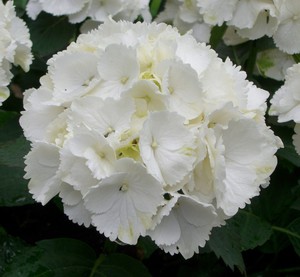 Large-leaved hydrangea (Hydrangea macrophylla) is the very species that first conquered Europe. Its large bushes, covered with bright green leaves and large inflorescences-balls are a real decoration of the garden. Inflorescences can have all sorts of colors in various shades of blue, pink and white flowers... There are varieties with yellowish leaves and unusual coloration of the stems. Hydrangeas of this type do not feel well in the bright sun and need partial shade... Timely abundant watering is very important for them. To obtain a blue color of flowers, mulching with leaf humus, spruce needles and peat is recommended, in addition, aluminum alum is used for irrigation at the rate of 2 g per 1 liter of water. It requires shelter for the winter and needs more care than other species.
Large-leaved hydrangea (Hydrangea macrophylla) is the very species that first conquered Europe. Its large bushes, covered with bright green leaves and large inflorescences-balls are a real decoration of the garden. Inflorescences can have all sorts of colors in various shades of blue, pink and white flowers... There are varieties with yellowish leaves and unusual coloration of the stems. Hydrangeas of this type do not feel well in the bright sun and need partial shade... Timely abundant watering is very important for them. To obtain a blue color of flowers, mulching with leaf humus, spruce needles and peat is recommended, in addition, aluminum alum is used for irrigation at the rate of 2 g per 1 liter of water. It requires shelter for the winter and needs more care than other species.- Paniculata hydrangea (H. paniculata) has beige pyramidal inflorescences, which gradually turn pink by autumn. This plant has a very strong growth and can give up to two meters of growth per year, therefore it needs strong annual pruning. It can grow into a large tree up to 10 meters tall. From summer to late autumn, panicle hydrangea is covered with flowers and has a very decorative look. It is very hardy, hardy and grows for a long time in one place, does not require special care, which makes it a valuable plant for urban landscaping.
 Stalked hydrangea (H. petiolaris) is a climbing shrub that can climb a support to a height of 25 meters using tenacious aerial roots. In nature, it braids tree trunks, so it loves partial shade. If it does not find a suitable support, it spreads along the ground. Stalked hydrangea is a wonderful honey plant. It looks great against the background of plants with dark leaves.
Stalked hydrangea (H. petiolaris) is a climbing shrub that can climb a support to a height of 25 meters using tenacious aerial roots. In nature, it braids tree trunks, so it loves partial shade. If it does not find a suitable support, it spreads along the ground. Stalked hydrangea is a wonderful honey plant. It looks great against the background of plants with dark leaves.- Serrata hydrangea (H. serrata) differs in umbellate inflorescences, the diameter of which is about 15 cm. This is a light-loving shrub that grows up to 1.5 m tall, requiring abundant watering. This plant requires good fertile soil, for which it thanks generously with long, abundant flowering.
- Treelike hydrangea (H. arborescens) has a height of up to 2 meters. Its inflorescences are large white balls. This is a good honey plant. The plant is moderately frost-resistant; it quickly recovers when frozen. Grows well in bright places on fertile, well-moisturized soils. Has excellent decorative qualities.
- Radiant hydrangea (H. radiata) is a shrub up to 2 m high. A distinctive feature is the silvery shade of the leaves. Shield-shaped inflorescences of white color have a diameter of about 12 cm and adorn the plant from July to August. Prefers acidic soils, well-lit places, tolerates light shading. Requires shelter of the root system for the winter with foliage or earth. It recovers well when frozen.
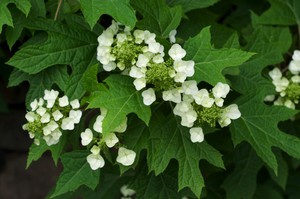 Oak-leaved hydrangea (H. quercifolia) has rough leaves resembling oak leaves. Its growth reaches 2 m. It has conical white inflorescences. The autumn color of the foliage, which has shades from burgundy to purple, is very decorative.
Oak-leaved hydrangea (H. quercifolia) has rough leaves resembling oak leaves. Its growth reaches 2 m. It has conical white inflorescences. The autumn color of the foliage, which has shades from burgundy to purple, is very decorative.- Bretshneider's hydrangea (H. Bretshneideri) is a large deciduous shrub up to 4 m high and up to 3 m in diameter with very large dark green leaves. An excellent option for a hedge, since the plant is frost and drought resistant. Autumn color of leaves is yellow-brown. Inflorescences are corymbose, abundant and regular flowering.
- Hydrangea Sergent (H. Sargentiana) is distinguished by very large inflorescences up to 30 cm, consisting of a ring of pink flowers surrounding a purple center, and velvety dark green leaves. The height of the bush is up to 4 m. Flowering occurs in late summer. It is a good honey plant.
 Indoor hydrangea grown in pots will be a wonderful window sill decoration if properly cared for. For these purposes, thermophilic evergreen varieties are used. The plant will delight with its flowering from spring to late autumn, enlivening the interior with green foliage in winter. The color of the inflorescences can be very different - from white and pale blue to red and purple. Very often the color changes gradually from the beginning of flowering to the end. In the warm season, pots with hydrangeas can be taken out into the garden or on the balcony, not forgetting about regular watering and shading from the hot sun.
Indoor hydrangea grown in pots will be a wonderful window sill decoration if properly cared for. For these purposes, thermophilic evergreen varieties are used. The plant will delight with its flowering from spring to late autumn, enlivening the interior with green foliage in winter. The color of the inflorescences can be very different - from white and pale blue to red and purple. Very often the color changes gradually from the beginning of flowering to the end. In the warm season, pots with hydrangeas can be taken out into the garden or on the balcony, not forgetting about regular watering and shading from the hot sun.
Reproduction of hydrangeas
There are several ways to get new plants. Each of them has its own characteristics. Such breeding methods are possible:
- grafting;
- obtaining layering;
- dividing the bush;
- sowing seeds;
- graft.
They differ in complexity and laboriousness, and also depend on the variety, since some hydrangeas have sterile flowers and reproduce only vegetatively.
Cuttings
This is the most common breeding method for hydrangeas. Types of cuttings are:
- spring;
- summer;
- winter.
With the onset of June, spring cuttings are cut from young shoots with a heel - part of last year's growth. Summer July cuttings are harvested from the non-lignified part of the branches. Use the tops of the shoots with two internodes, the leaf plates are cut to the middle to reduce moisture evaporation.
A mixture of peat and sand in a ratio of 2: 1 or sheet soil is used as a soil, on which a layer of sand is poured. A prerequisite for caring for hydrangeas is to ensure high humidity - constant watering or artificial fog. Rooting lasts three to four weeks. Usually, the percentage of rooted cuttings is very high, especially when treated with growth stimulants. In cold regions, rooted cuttings are grown in greenhouses, basements or pots, where it is easier to care for them until they are planted in a permanent place after two years.
Large-leaved hydrangea can be propagated by winter cuttings. To do this, the mother bush is transplanted into a pot in the fall and kept at a temperature of about zero. In the middle of winter, the plant is transferred to a room with a temperature of about 10 ° C, where after two weeks, the kidneys begin to wake up... In February, the shoots reach the desired size and can be used for rooting just like summer ones.
Division of the bush and layering
Any hydrangea can be propagated by dividing the bush. To do this, in the spring or autumn, the bush must be dug up and the rhizome divided so that on each part there are several buds of renewal. Delenki are immediately planted in a permanent place and watered.
To obtain layering, last year's shoot is tilted to the ground and placed in a pre-prepared recess. Part of the shoot is sprinkled with earth so that several buds are covered with soil. The tip of the shoot about 20 cm long should be on the surface, and care consists in regular watering... The next year, the rooted layers can be transplanted. Shoot damage in the form of an incision in the underground part accelerates root formation.
Sowing seeds
With the help of seeds, species of hydrangeas are propagated. For this, the site is prepared in the fall. The garden bed should be 25 cm above ground level. It is dug up, bringing in peat and compost. In heavy soils, sand is required. Sowing begins in April or May, after removing all weeds and leveling the beds. Hydrangea seeds do not need any processing. They are scattered by hand, and sprinkled on top with a layer of sand. It is necessary to keep the soil moist, preventing it from drying out during seed germination. Shoots appear in about a month. Delicate seedlings require care and careful care - watering, weeding, regular feeding with nitrogen and potash fertilizers.
Hydrangeas are a great garden decoration both in single plantings and in groups with other ornamental shrubs, and it is not difficult to care for them.
Hydrangea is a tall shrub with gorgeous flowers that delight the eye for weeks or even months. This plant will decorate your garden almost all summer, and with the onset of autumn its flowers can be cut, dried and made from it. beautiful bouquet... Additionally, hydrangeas can grow and bloom where other flowers won't even take root.
When choosing a site for planting hydrangeas, pay attention to the preferences of this plant, unlike most flowers and shrubs, hydrangea does not like direct sunlight, on the contrary, they can slow down the growth and development of the bush, therefore it grows well in partial shade. In addition, hydrangea prefers acidic soil, which, as you know, is abundant in many summer cottages... So this makes hydrangea an ideal candidate for growing and decorating your garden. The plant is propagated by seeds, cuttings and layering. But to speed up the flowering time, it is better to use the second and third methods. In addition, hydrangea is sold in abundance as seedlings, often even already in bloom, but it is worth buying them in trusted places - shops or garden farms. Also, do not forget to clarify whether this variety is frost-resistant. Since among the large-leaved hydrangea with very beautiful spherical inflorescences, frost-resistant forms are not uncommon. Such flowers are grown in large pots or tubs and brought into a house or greenhouse for the winter.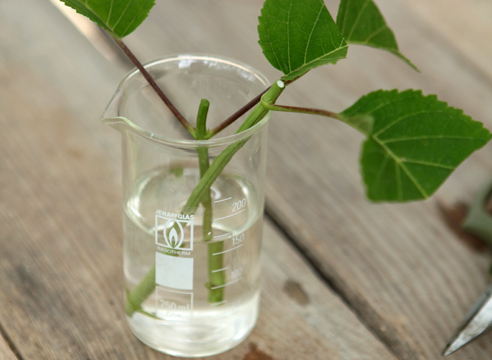
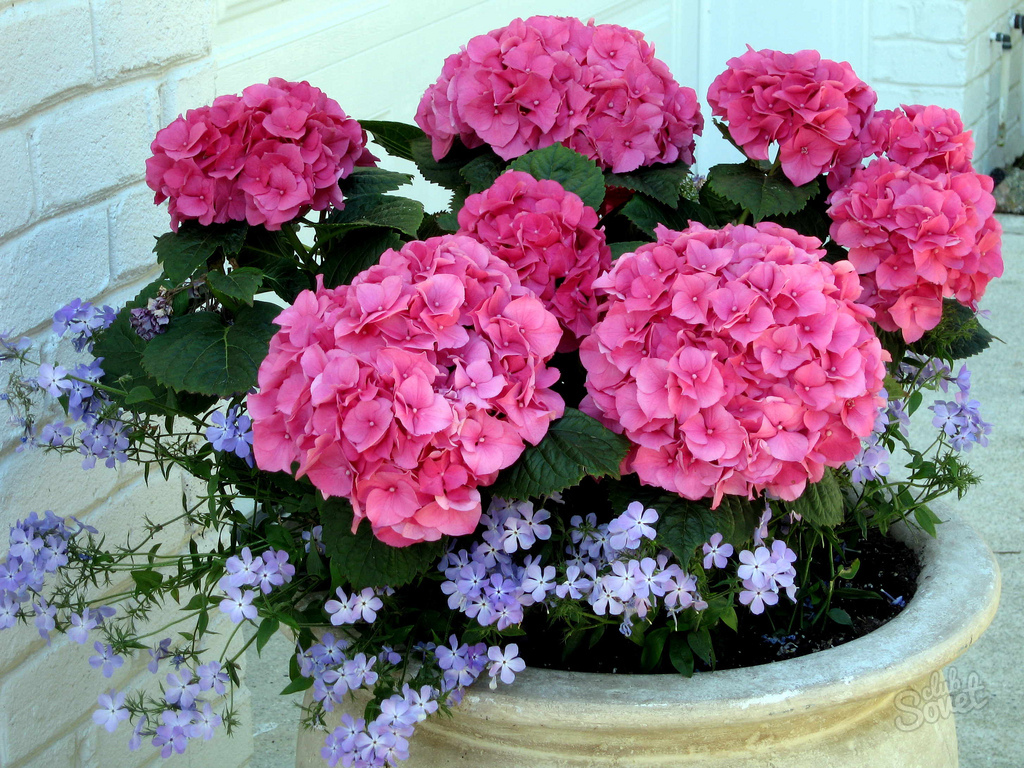
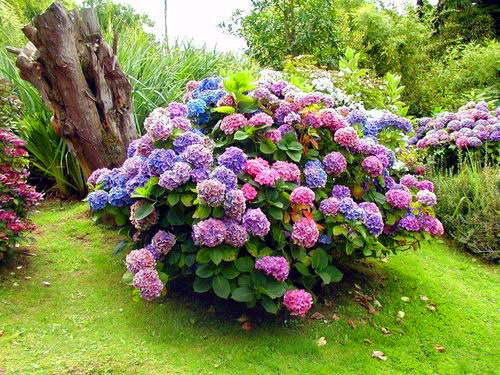
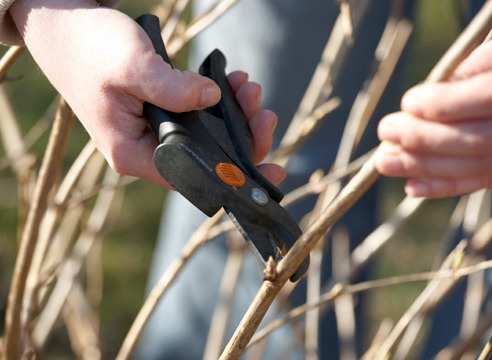
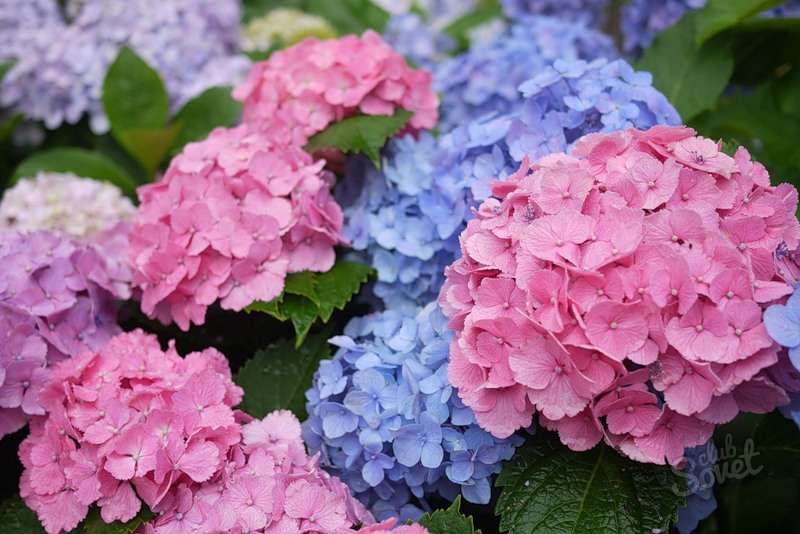
Hydrangea blooms from July to September - all this time, the bush is decorated with caps of flowers of white, pink, blue or lilac color. White hydrangea often turns pinkish red with the onset of autumn. Flowering bush with a hundred paniculate or globular inflorescences, it looks absolutely luxurious and will be a real work of art on your site.
Currant - is in second place in terms of distribution in industrial plantings after strawberries. This is due to a number of factors, this is frost resistance and drought resistance and ease of reproduction and the cheapness of planting material, coupled with a large number of varieties. However, currants have an abundance of diseases and pests. Today we will talk about one of these pests, the gall aphid, which causes quite significant damage to currants.
In nature, these giants, impressive in both beauty and size, are admirable for one of their views. Even in garden form, elms are luxurious woody only for very large areas. Not surprisingly, home-grown elms always seem like a small miracle, a truly exclusive plant. The art of bonsai helps to "tame" the ancient beauties, while maintaining the key features of these trees - a beautiful silhouette and unusual foliage.
Fish soufflé is a dietary recipe, according to which you can easily prepare a tender soufflé from boiled pollock, cod or hake. Of course, while on a diet, you can not waste time preparing delicious meals, but this, you see, is boring. You need to pamper yourself and accustom yourself to the fact that diet food should not only be healthy, but also tasty, beautifully cooked. Low-fat sea fish is loved by all nutritionists, and even more so when boiled or baked.
The standard of decorativeness and splendor of flowering, a magnificent garden rhododendron for many gardeners remains only a dream. The reputation of an exclusive plant has given rise to many rumors about the difficulty of growing and about low winter hardiness. And none of these rumors are justified, as is the myth that rhododendrons cannot be propagated by yourself. Rhododendrons can be grown from cuttings, cuttings, and even seeds to produce a luxurious flowering shrub at minimal cost.
Parsley is a versatile green crop used both raw in salads and dried as a seasoning. This culture belongs to the genus of herbaceous biennials and belongs to the Umbrella family. The very first mentions of this green culture were found by archaeologists on ancient Egyptian scrolls. She was so revered and in demand that many legends are told about her appearance. The most popular is usually leaf parsley.
Homemade chicken roll in the oven from chicken breast, legs and hearts is not difficult to cook. The main feature of the recipe is spices and seasonings. Fennel, smoked paprika, garlic and dried chili are successfully combined with chicken, and dried carrots will decorate the product not only with taste, but also add beauty. New Year's recipes do not have to contain the rarest ingredients; often, the most commonplace products make a culinary masterpiece if cooked with love.
Cold northern rooms are considered rare, but insufficient heating is more of a bonus for growing plants than a disadvantage. It is in these rooms that you can arrange the ideal rest period for many cultures. And although the level of illumination still forces you to carefully select candidates, cold rooms cannot be called difficult in landscaping. Rooms are called cold when the temperature in winter remains within the range of 10 to 15 degrees.
Curd muffins with candied pineapple fruits, raisins and bright pastry sprinkles will decorate your sweet festive table and will not take much time to prepare. Muffins turn out to be lush, moist, they have a lot of fillings. It is convenient to put such festive pastries in a beautiful box and take them with you. Muffins made with this recipe can be stored for 2-3 days in a sealed container. It is convenient to use silicone molds for baking.
Lupine belongs to the legume family and has been cultivated by humans for thousands of years. There is evidence that the first seed of lupine was thrown into the soil four thousand years ago. Its seeds contain half of the protein and about a third of the oil. Animals eagerly eat both seeds and the entire aerial mass of lupine, from which they quickly gain weight and rarely get sick. Currently, there are about two hundred species of lupine known. We will talk today about three of them - annual species.
Alpine slides - an irreplaceable element of garden design. And it's not only about imitating the special charm of mountain corners, but also about expanding the possibilities to grow plants in the garden that prefer stony, light and dry soils. In symbiosis with stone, the best of the decorative deciduous creeping plants fully reveal their beauty. Indeed, it is on rock gardens that hardy ground covers most fully manifest the beauty of both their textures and color.
Oven cutlets are an easy dish to cook, and little culinary tricks make it not only tasty, but also beautiful. You will have time to cook cutlets with topping and cherry tomatoes in less than an hour, you will agree that for meat dish in the oven it is quite a bit. Any meat for cooking cutlets is suitable - turkey, chicken, veal, but always remember that delicious cutlets are obtained from good meat. It is not worth saving on this.
Rooting stimulants are used to stimulate growth and development, as well as for the actual formation of the root system in the cuttings. Of course, root formation stimulants cannot be called those wonderful drugs that can "resurrect" a lignified stalk and lead to the formation of roots on it. But if you strictly follow the timing of cutting shoots, cutting them into cuttings and planting them in a greenhouse, then root formation stimulants will definitely help.
Outwardly more reminiscent of myrtles, their close relative Eugenia cannot boast of the same popularity. Dense foliage, ease of molding are the main prides of this plant, thanks to which it is used for bonsai or indoor topiary. But still, most of all in indoor eugenias is attracted by a gentle, almost pastoral flowering. In addition, this magnificent plant belongs to not too difficult crops to grow and real long-livers.
Homemade sprat tastes better than store-bought sprat - that's a fact! Sprat ambassador at home is a simple process, you must admit that putting the fish in the brine will not be difficult. In this recipe, I spent a little more time, since I cleaned the fish from the heads and entrails and filled it with oil. It turned out something like anchovies. Fish fillets ripe well in oil, looks very good on a piece of fresh rye bread, with butter and green onions.
Tulip fever, which began in Holland half a millennium ago and took over the whole world, continues today. There is not a single grower or gardener who would not dream of expanding his collection of tulip varieties and who would not be familiar with this special bulbous star. Tulips do not need an introduction, but the nuances and subtleties of this in their cultivation does not diminish, as well as the options for their use in the design of a flower garden and garden.
Instructions
Planting hydrangeas is carried out in 2 terms - in the first half of May and in September. If you have purchased a small bush in a pot, it has a closed root system, then you can plant from early May to late September.
Choose a location. Hydrangea grows well both in the sun and in light partial shade. The bush likes to get enough moisture, so plant it where there is plenty of it.
Dig a hole 50 cm in diameter and 60 cm deep. If you want to place several bushes, then plant them at a distance of one and a half meters from each other. Fill the grooves with fertile soil. To do this, mix 1 part sand, peat with three parts of humus. Add a tablespoon of complete mineral fertilizer with trace elements to 1 hole. Mix the contents of the well with a shovel, pour 5 liters of water.
Place a seedling, cover it with soil. In this case, the root collar should be at ground level. Shade the plant. Do not remove the shelter until the bush takes root.
Water the plants abundantly. For one adult - 10-15 liters at a time. In dry weather, this is done every 5 days. In total, it is necessary to feed the hydrangea 4 times during the season. For the first time after winter, feed the bushes during the awakening of the buds or at the beginning of the growth of the leaf mass - at the end of April. Make a nitrogen fertilizer by stirring a liter can of slurry in 10 liters of water. Let the solution sit for 3 days, then water over damp ground.
Feed the bushes a second time during the budding period. Add one spoon of double superphosphate and potassium sulfate to 10 liters of slurry solution. To dissolve the superphosphate, first fill it with a liter of boiling water, leave it in this form for a day, and then pour it into the manure infusion.
Water the hydrangea for the third time with organomineral fertilizer according to the second recipe during the period of mass blooming of flower brushes. Feed the bushes for the fourth time at the end of August. Dissolve 2 tablespoons of superphosphate and one of potassium sulfate in 10 liters of water. This infusion will help the hydrangea winter better.
Trim all flower brushes by mid-October. At the end of this month, cover the bush with a layer of peat 10-15 cm thick. If the winter is going to be harsh, then put a layer of dry leaves 5 cm thick on top, and on them - several spruce branches.
note
Do not pour lime into the planting hole and under the plant itself, as hydrangea loves acidic soil. Lime reduces this figure.
Dry the inflorescences cut with part of the branches in October. Lower them upside down and place in a dark, ventilated place. Such a bouquet of dried flowers looks beautiful.
Hydrangea is a real decoration of the garden. Luxurious flowers are amazing, their beauty, variety and color palette are amazing. A riot of inflorescences of white, purple, pink and even blue, crowning long peduncles, delight the eye and arouse admiration. Even hydrangea leaves, bright green and soft, are pleasing to the eye. Plant and grow hydrangea not difficult, you just need to know certain rules.
You will need
- - a sapling of hydrangea;
- - shovel;
- - watering can;
- - potting soil (if necessary);
- - mulch.
Instructions
Decide on a place for hydrangeas in your garden. This is one of the most important points when planting this flower. Firstly, it will help to determine the specific type of hydrangea, because some species reach a height of more than 3 meters, others are short and lush. When choosing a location, you must take into account the presence of sunlight - at what hours and for how long the flower will receive it. Hydrangea loves maximum sunshine in the morning and shade in the afternoon. The area where you plan to plant hydrangeamust be protected from the wind. The flower does not tolerate drafts, it will simply begin to wither and eventually wither. The hydrangea is unpretentious to the composition of the soil, but it loves a mixture of several lands (leafy, turfy, sandy, etc.). Even if it is a dry area, good watering will fix everything.
The best time to plant hydrangeas is early fall. In the area that you have identified for the flower in advance, dig a planting hole. It should be twice as large as the root ball of the seedling in a container (pot, jar, container, etc.) that you bought in a store or market. If the soil in this place is solid, the depth of the hole should be dug taking into account the length of the future root of an adult plant, and then sprinkled with loose earth. It is advisable to pour compost into the hole (several
A flowering plant such as hydrangea (Hydrangea) is directly related to the hydrangea family. According to various sources, this genus unites 30–80 species of hydrangeas. Such plants are represented by compact trees, vines and shrubs. Most of the types of hydrangeas grow in the South, as well as East Asia (China, Japan), this plant can also be found in North America and on Far East... Such a plant was named after the princess of the Holy Roman Empire. Systematics scientists gave the plant the Latin name Hydrangea, which means "a vessel with water". The fact is that it is highly moisture-loving. In Japan this plant is called "adzisai", which means "flower - purple sun". Despite a large number of species, at home grow only garden hydrangea, or large-leaved, having a small size. Other species and varieties are grown exclusively in gardens.
In the wild, hydrangea is represented by three-meter shrubs, not very large trees, as well as lianas, which can climb up tree trunks to a height of thirty meters. Also, such hydrangeas can be deciduous or evergreen (depending on the species). In the middle latitudes, deciduous species are most preferred. Most often, such a plant has large opposite leaves, they have an oval shape with a pointed tip at the top. The edge of the leaf blades is most often serrated, and venation is clearly visible on their surface. Hydrangea begins to bloom in the spring, and ends only after the onset of frost in the fall. The flowers are collected in large inflorescences, which can have a corymbose, spherical or paniculate shape. The inflorescences include 2 types of flowers. Some of them are small fertile (fertile), usually located in the middle of the inflorescence, while others are large sterile (sterile), which are located along the edge of the inflorescences. There are species with only one fertile flowers. Most hydrangeas have flowers painted in white color... However, there are species, for example, large-leaved hydrangea or large-leaved, which can have flowers of various colors: cream, white, blue, pink, red and lilac. At the same time, it is interesting that the pH of the soil affects the color of the flower. So, for example, if the substrate is neutral, then the flowers will be cream or beige, if alkaline, then pink or lilac, and on sour - blue, because the soil contains aluminum that is easily absorbed by hydrangea. The fruit of this flower is a box with 2-5 chambers containing small seeds. It happens that a hydrangea is mistakenly called a flower belonging to a close genus schizophragmatic, but you should know that petiolar hydrangea is nothing more than a schizophragma.
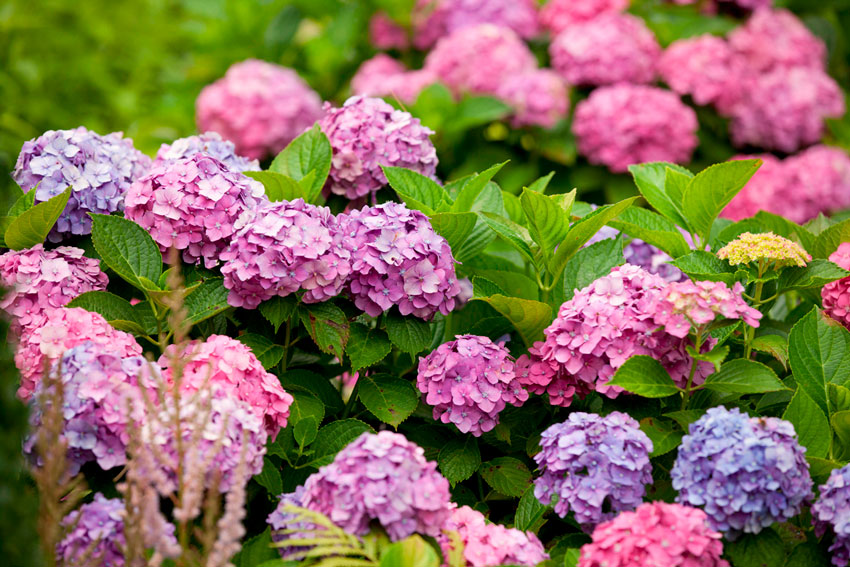
How to properly grow hydrangea in the garden? Here are the basic rules:
- Large-leaved hydrangea can have a different color of flowers. Moreover, their color does not depend on the variety, but on the pH of the soil. So, in acidic soil, the flowers are blue and blue, in neutral soil - white and beige, and in alkaline soil - lilac or pink. In order for the bush to be spectacular and colorful, experienced gardeners are advised to change the acidity separately for each flower.
- This flower is very fond of moisture, in this regard, it must be watered not only abundantly, but also on time.
- Direct rays of the sun are required. But it should be borne in mind that flowers can fade under the influence of the scorching rays of the midday sun. In this regard, you need to choose a place for planting, where there would be little shade at noon.
- Also, the plant must be cut off in time.
- You cannot apply a lot of organic fertilizers, because flowers may not appear on the overgrown bushes.
- Hydrangea must be covered well for wintering, even those species that are considered frost-resistant. If any of the bushes freezes, then in most cases it will be able to fully recover during the period of intensive growth.
- Very resistant to diseases and pests.
Planting hydrangeas

Seeds are usually very easy to propagate for species of hydrangea. Also, this breeding method is often used by breeders in their work. It is quite easy to grow such a flower from a seed, but it is a time-consuming method. You need to sow seeds in the autumn. To do this, you need to fill the container with a loose earth mixture rich in nutrients, which can be prepared by combining peat and leaf soil with river sand in a ratio of 2: 4: 1. Seeds sown on the surface of the substrate should be sprinkled with a thin layer of soil, and then watered with a spray bottle. Then the container must be covered from above with a transparent film or glass, while the shelter must be removed several times at knocks in order for the soil to be aired. It should also be taken into account that the soil should be slightly moist all the time. The optimum temperature is from 14 to 20 degrees. After the first seedlings appear, the shelter must be removed permanently. The pick must be done 2 times. The first time in the developmental stage of the cotyledons, and the second - in the first month of spring. At the same time, when diving a plant for the second time, you need to take small pots for each of them (diameter 7 centimeters). After you transplant young plants a second time, you need to start hardening them. For this, flowers in summer time They take them out into the street and choose a place for them that is protected from direct sunlight, gusts of wind, drafts and precipitation. In the evening, the hydrangeas are returned to the room. For 2 years, the hydrangea must be grown indoors, and in the winter it is kept in a fairly cool and lighted room, and in the summer it is transferred to the street. In this case, it is imperative to cut off all the buds, since they will take a lot of energy from a still young plant.
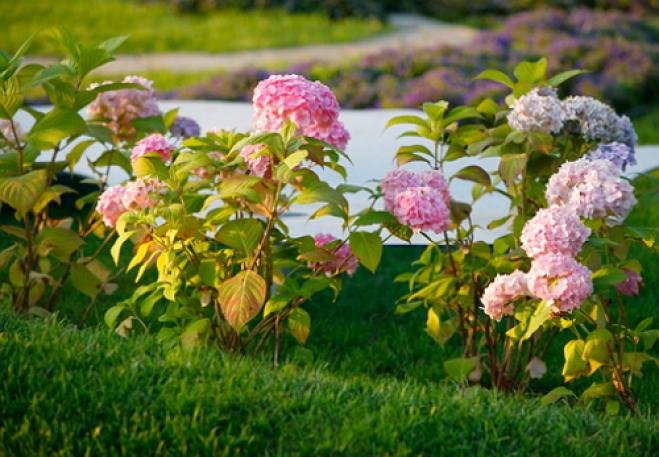
After 2 years, at the very beginning of the spring period (in areas with a cold climate - in the autumn), the grown flowers are transplanted into open soil, immediately to a permanent place. When choosing a suitable place, do not forget that all species are photophilous and need direct sunlight. However, there are several species (ground cover, Sargent, rough and tree) that thrive in partial shade. The soil should be loose, rich in organic matter, neutral or slightly acidic. Alkaline soil can be acidified by taking high-moor peat or Acid Plus acidifier. It is not recommended to plant trees or shrubs with a surface root system next to these flowers, since after some time these plants will fight with each other for water and nutrients.
The first step is to dig a hole, while its size should be 2 times the volume of the root system of the seedling together with the pulled out lump of earth. Then organic and mineral fertilizers, as well as peat, must be added to the hole, which should be mixed with the ground. Then the seedling taken out together with a lump of earth must be thoroughly shaken off the soil and the roots must be aligned. Then it is lowered into a hole, which is covered with a mixture of compost and soil. In this case, it is necessary for the root system to rise very slightly above the soil surface. Then the soil should be compacted, the bush should be watered and the area should be covered with mulch (bark or needles).
Outdoor Hydrangea Care
Basic rules of care
To care for such a plant grown in open ground, not difficult, but it must be done correctly. Of great importance for the normal development of hydrangea is correct watering... So, in hot weather it needs to be watered 2 times in 7 days, while 3-5 ten-liter buckets of lukewarm and always settled water should be poured onto 1 adult bush. In the event that there is mulch in the form of peat on the site, then watering can be reduced.
In order for the roots to receive more oxygen, it is necessary to loosen the soil surface around the plant several times a season to a depth of about 5 centimeters. You also need to promptly cut off those stems that have already faded.
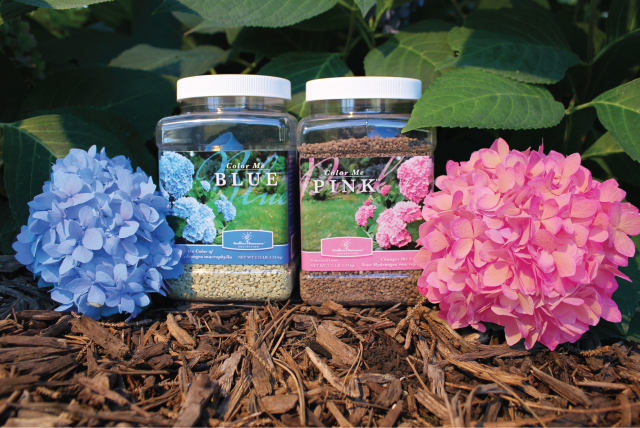
In order to achieve the most abundant flowering, you need to feed such a flower at least 2 times a year. This must be done before the plant begins to bloom and after it has faded. At the very beginning of the spring period, a urea solution (2 g per 1 liter of water) is used to feed hydrangeas. In this case, 1 bush will need 30 liters of this solution. When the plant has faded, a complex mineral fertilizer should be used to feed it. During the summer period, experts advise using slurry as top dressing. However, do not overdo it, because overfed hydrangeas have very large inflorescences that can break rather fragile branches. To avoid this, you can tie up a bush.

Should be cut off those bushes that are older than 3-4 years. Species blooming on the stems of the current year should be cut off at the very beginning of the spring period, before the buds begin to open, as well as before the start of sap flow, otherwise the plant may drain out of juice, which will lead to its death. However, after pruning done very early, cuttings should not be rooted. Therefore, pruning should be done at a time when the buds look alive and swell a little. The tree hydrangea is the very first to wake up, so it must be cut off first. Very long stems are cut off at a height of 3-4 buds. After that, the resulting twig can be divided into cuttings. Panicle hydrangea requires more careful pruning. So, last year's stems must be shortened by 1/3 part, but viable cuttings are obtained from such segments. Large-leaved hydrangea does not need to be heavily pruned. So, in spring, only every 4th stem is cut off, especially if it grows inside the bush. And also it is necessary to remove dried and damaged branches.
Propagation of hydrangea by cuttings
After pruning the hydrangea, you will have a large number of stems that can be cut into cuttings. Each of the cuttings should have 2 nodes. In this case, the cut above the node located at the top should be straight, and under the one below it should be oblique. In this case, 2-3 centimeters should be retreated from the knot, and then a cut should be made. Fill the greenhouse container with a mixture of peat and sand and stick the cutting to a depth of 3 centimeters, while watering it well. After that, the greenhouse should be covered from above plastic wrap "House". The cuttings must be systematically moistened with a spray bottle so that the soil is always slightly moist. After complete rooting, the cuttings should be planted in open soil in a permanent place. They should have time to get stronger before winter.
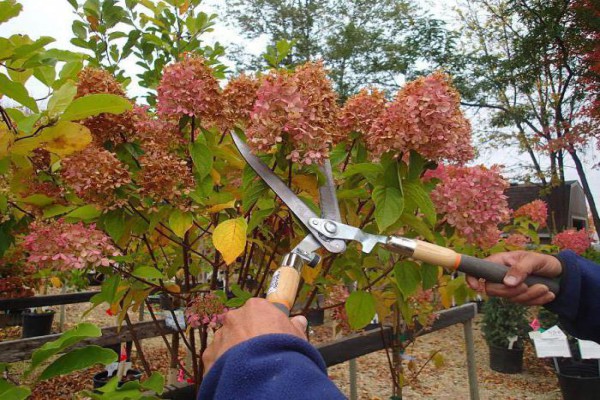
A faded plant must be prepared for wintering. Saplings that are grown in containers must be moved indoors. For flowers growing in open ground, you need to cut off wilted flowers, because when wet from rain and snow, they will become very heavy and can break branches. And it will also be necessary to huddle the base of the bushes high enough, fill the soil surface around them with a layer of mulch, which will help protect the root system from freezing. The most frost-resistant species are ground cover and paniculate. The stems of such plants are completely lignified before the onset of the autumn period, which helps them to more easily endure frosts, even if they are not covered (when grown in areas with mild winters). Also, you can not cover the tree hydrangea for the winter.

Preparing hydrangeas for winter
A rather warm and snowy winter period allows even species that love warmth (serrated and large-leaved hydrangea). However, it should be borne in mind that winter will be frosty or warm, no one knows for sure how and how much snow will fall. It is better to play it safe and, despite the fact that forecasters promise a warm winter, prepare the plants for wintering properly. Because if the forecast of weather forecasters is incorrect, then plants unprepared for wintering may die.
What is the best time to cover this flower and how to do it? As a rule, this procedure is carried out in October, after the first frosts have passed. If the bushes are young, then they should be covered to the top with dry soil. The grown bushes must be pressed to the soil surface and covered with roofing material or lutrasil. They must be fixed with bricks, since such a shelter can be blown away by the wind. More mature bushes will require more energy. The bush must be carefully tied and then covered with spunbond or lutrasil. After that, a metal mesh frame should be created around the bush, which should have a cylindrical shape. In this case, the walls of the structure should be 20-25 centimeters away from the bush, and they should also rise 10 centimeters above it. Empty space in the structure should be filled with dry leaves. In springtime (in April) the net with leaves can be removed, but the spunbond is removed only after the threat of frost has passed.
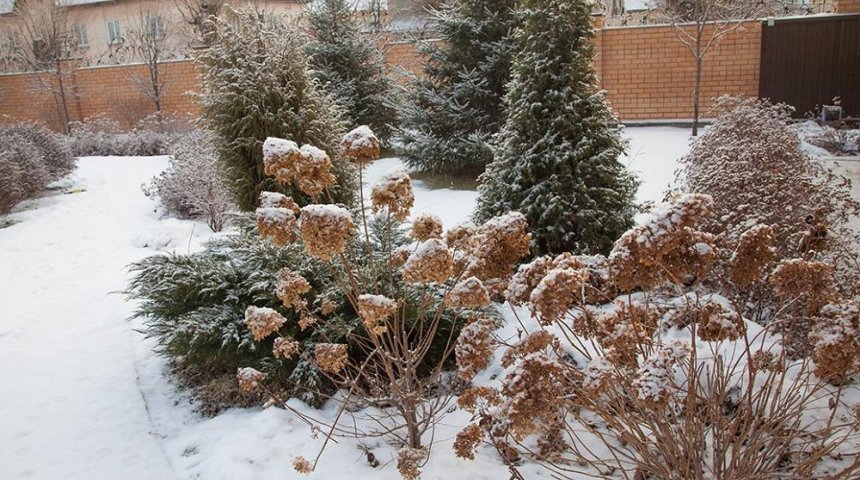
You yourself can decide whether to cover these flowers for you or not. The options above are ideal for a frosty winter with poor snow cover. In the event that in the place where you live there is a very mild winter, then covering the hydrangea can be quite easy. And if you have winter-hardy species, then they can not be covered at all. However, if the winters where you live are often frosty, then it is better to take care of a shelter for the hydrangea in the autumn, and then you will definitely be sure that it can survive even severe frosts.
Types of hydrangea photos and names
If you are thinking about decorating your garden with hydrangea, then first of all you should pay attention to the features of the various types of this plant. Then you will be able to choose exactly those species that will best suit your garden. It is also important to know how each species needs to be looked after. For example, a tree or large-leaved hydrangea must be prepared for wintering and cut somewhat differently than panicle hydrangea. If you know a lot about the rules for caring for such plants, then caring for them will not be difficult.

This variety is very popular among gardeners living in mid-latitudes. This plant is represented as a shrub. Its height can vary from 100 to 300 centimeters. Inflorescences grow on the tops of annual stems. When the flowers are just beginning to open, they have a light green color, after their full disclosure, they change their color to cream or white. The most popular varieties are: "Invizible Spirit" - flowers have a pink color; "Sterilis" - inflorescences are white, while this plant blooms very profusely; "Annabelle" and "Grandiflora" - have very large inflorescences, painted in pure white color (note that panicle hydrangea has varieties with exactly the same names).
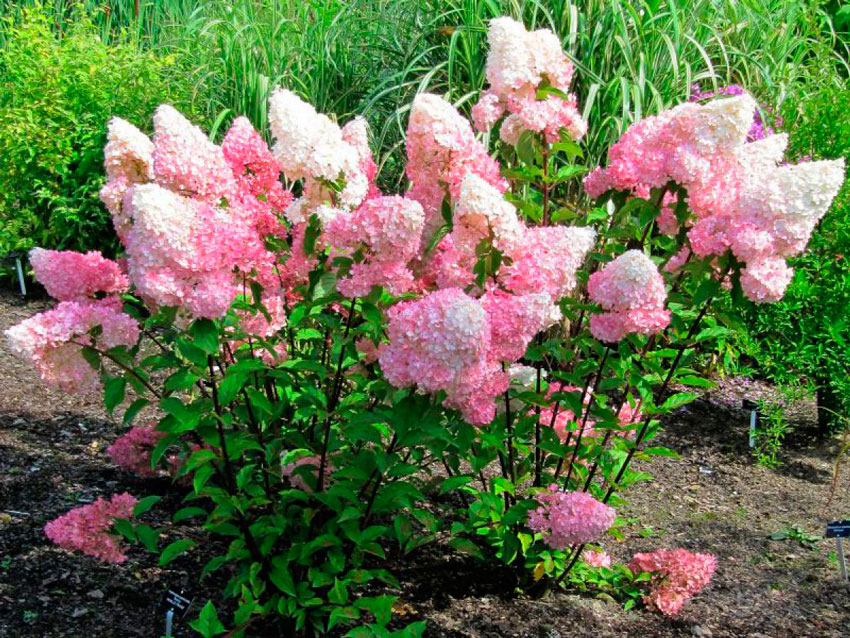
Under natural conditions, such a plant has the shape of a tree or a shrub, the height of which can vary from 2 to 5 m. This species is considered one of the most popular among gardeners. Without transplanting in the same place, this type of hydrangea is able to grow and develop normally for more than 40 years. The stems of this plant are lignified in a relatively short time, which is why it is considered winter hardy. The inflorescences grow in the upper parts of the stems of this year, while the flowering is distinguished by its abundance. However, the buds formed in the last days of June open only in August or September. The inflorescences of this type of flowers have a pyramidal shape. When only the flowers begin to open, they have a pale green color, and after full disclosure, they turn white. At the end of the summer period, they turn light pink, and then brick. When the flowering period begins to end, the flowers turn light green again. The most popular varieties: Grandiflora, Kuishu, Vanilla Fraze"And" Tardiva ".

Or garden - it is often cultivated in the garden. However, individual varieties can be grown in containers indoors or on the terrace. Dense leaves have a rich green color. The stems of this year are herbaceous, which is why the bush has not very high cold resistance. It is believed that inflorescences appear on the stems of last year, since the buds for their growth are laid in the autumn, and they begin to grow in the spring. As a rule, inflorescences have a viburnum-shaped, umbellate shape, it is also called hemispherical or Japanese. The color of the flowers depends on the pH of the soil. Recently appeared interesting varieties: "Endless Summer" - in acidic soil - blue color, in neutral - lilac; Renata Steinger - blue; "Expression" and "Romance" - have double flowers.

It has low frost resistance and needs good insulation for the winter. It blooms very luxuriantly and has unusually attractive leaves. It has a height of about 2 m. The length of paniculate inflorescences is from 10 to 30 centimeters. Flowering begins in June-July, while at the beginning the flowers are white, and then turn purple.

Or hydrangea with different pubescence - a winter-hardy species. Under natural conditions, it can reach a height of 200-300 centimeters. Often used to form a standard form. The length of the dark green leaves is about 20 centimeters. Their front side is smooth, and the seamy side has pubescence. Loose corymbose inflorescences are initially white, and then turn pink at the end of flowering. Flowering begins in the last June days or the first July. The most popular ground cover variety Bretschneider, which blooms profusely with rather large inflorescences of a milky white color.
Also, gardeners grow hydrangeas: ash, serrate, radiant, rough, Sargent. They also grow a climbing type of petiolate hydrangea, but as mentioned above, this is not a hydrangea.




